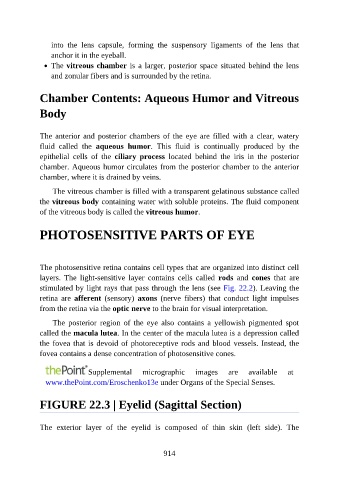Page 915 - Atlas of Histology with Functional Correlations
P. 915
into the lens capsule, forming the suspensory ligaments of the lens that
anchor it in the eyeball.
The vitreous chamber is a larger, posterior space situated behind the lens
and zonular fibers and is surrounded by the retina.
Chamber Contents: Aqueous Humor and Vitreous
Body
The anterior and posterior chambers of the eye are filled with a clear, watery
fluid called the aqueous humor. This fluid is continually produced by the
epithelial cells of the ciliary process located behind the iris in the posterior
chamber. Aqueous humor circulates from the posterior chamber to the anterior
chamber, where it is drained by veins.
The vitreous chamber is filled with a transparent gelatinous substance called
the vitreous body containing water with soluble proteins. The fluid component
of the vitreous body is called the vitreous humor.
PHOTOSENSITIVE PARTS OF EYE
The photosensitive retina contains cell types that are organized into distinct cell
layers. The light-sensitive layer contains cells called rods and cones that are
stimulated by light rays that pass through the lens (see Fig. 22.2). Leaving the
retina are afferent (sensory) axons (nerve fibers) that conduct light impulses
from the retina via the optic nerve to the brain for visual interpretation.
The posterior region of the eye also contains a yellowish pigmented spot
called the macula lutea. In the center of the macula lutea is a depression called
the fovea that is devoid of photoreceptive rods and blood vessels. Instead, the
fovea contains a dense concentration of photosensitive cones.
Supplemental micrographic images are available at
www.thePoint.com/Eroschenko13e under Organs of the Special Senses.
FIGURE 22.3 | Eyelid (Sagittal Section)
The exterior layer of the eyelid is composed of thin skin (left side). The
914

